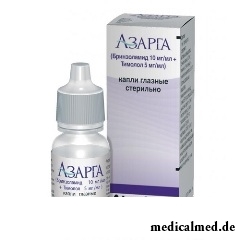





Azarga
Application instruction:
 Azarga – the combined protivoglaukomny means containing inhibitor of a karboangidraza II and a non-selective blocker of beta adrenoceptors.
Azarga – the combined protivoglaukomny means containing inhibitor of a karboangidraza II and a non-selective blocker of beta adrenoceptors.
Form of release and structure
Dosage form – drops eye: homogeneous suspension of almost white or white color (on 5 ml in plastic bottles droppers of "Droptainer™", in a pack a cardboard 1 bottle).
Contain in 1 ml of drops:
- Active ingredients: бринзоламид – 10 mg; Timololum (in the form of a maleate) – 5 mg;
- Auxiliary components: a benzalkoniya chloride (50% solution), sodium chloride, sodium hydroxide, dinatrium эдетат, тилоксапол, Mannitolum, the water purified.
Indications to use
The Azarga is applied to decrease in the increased intraocular pressure at intraocular hypertensia and an open angle glaucoma in case of inefficiency of monotherapy.
Contraindications
Absolute:
- Closed-angle glaucoma;
- Allergic rhinitis of a heavy current;
- Hyperreactivity of bronchial tubes;
- Chronic obstructive diseases of lungs of a heavy current;
- Bronchial asthma (in the anamnesis including);
- Cardiogenic shock;
- The expressed heart failure;
- Atrioventricular block of the II-III degree;
- Sinus bradycardia;
- Heavy renal failure (clearance of creatinine less than 30 ml/minute);
- Giperkhloremichesky acidosis;
- Age up to 18 years;
- Period of pregnancy and lactation;
- Simultaneous use of peroral inhibitors of a karboangidraza;
- Hypersensitivity to components of Azargi, sulfonamides or beta adrenoblockers.
Relative (drops apply with care):
- Hyperthyroidism;
- Printsmetal's stenocardia;
- Arterial hypotension and cardiovascular diseases;
- Disturbances of the central and peripheric circulation;
- Pseudo-exfoliative glaucoma;
- Pigmental glaucoma;
- Tendency to a hypoglycemia;
- Diabetes mellitus, especially labile current;
- Myasthenia;
- Disturbances of acid-base balance;
- Liver failure;
- Atopy or heavy anaphylactic reactions to various allergens in the anamnesis.
Route of administration and dosage
The Azarga is applied locally. Before use it is necessary to stir up a bottle.
Drug is appointed on 1 drop in a conjunctival sac of an eye by 2 times a day.
For decrease in risk of development of system side effects after instillation it is recommended to press accurately for 1-2 minutes a finger on area of a projection of dacryocysts at an internal corner of an eye (it allows to reduce system absorption of drug).
In case of the admission of the next instillation it is necessary to continue use of medicine from the following dose according to the schedule. It is not necessary to exceed the recommended daily dose.
In case of the previous use of other protivoglaukomny drug to begin to apply Azargu it is necessary next day after cancellation of the previous means.
Side effects
Gradation of side effects from bodies and systems for the following scale: often – from> 1/100 to <1/10; infrequently – from> 1/1000 to <1/100; frequency is unknown – it is not possible to estimate frequency reliably or to establish a direct connection with administration of drug:
- From a nervous system and mentality: often – disgevziya1, infrequently – bessonnitsa1, frequency is unknown – head bol1, depressiya1, golovokruzheniye1,2, cerebrovascular narusheniye2, cerebral ishemiya2, obmorok2, loss pamyati2, strengthening of signs and symptoms of a myasthenia of gravis2, koshmary2,3, parestezii2,3, night nervoznost3, apatiya3, deterioration pamyati3, amneziya3, sonlivost3, depressive nastroyeniye3, gipesteziya3, tremor3, agevziya3, motor disfunktsii3, decrease libido3;
- From an organ of sight: often – pain in glazu1, misting zreniya1, irritation glaz1; infrequently – a syndrome of "a dry eye" 1, fotofobiya1, dot keratit1, a hyperemia glaz1, a hyperemia konjyunktivy1, a hyperemia sklery1, raised slezotecheniye1, allocations from glaza1, feeling of a foreign body in glazakh1, an erythema vek1, an exudate in an anterior chamber glaza1, an erosion rogovitsy1, an itch in glazu1,3; frequency is unknown – disturbance zreniya1, swelled vek1, decrease in sensitivity rogovitsy2, ptoz2, choroid amotio after filtering operatsii2, keratit2,3, decrease in sharpness zreniya2,3, diplopiya2,3, frustration zreniya3, deposits in glazu3, defect of an epithelium rogovitsy3, the increase in excavation of a disk visual nerva3, madaroz3 increased slezotecheniye3, allergic reactions glaza3, pterigium3, increase intraocular davleniya3, a swelling glaz3, a sensation of discomfort in glazu3, disturbance of an epithelium rogovitsy3, konjyunktivit3, keratopatiya3, an inflammation meibomian zhelez3, pigmentation sklery3, a contrast decrease zreniya3, coloring rogovitsy3, Sukhoi keratokonjyunktivit3, fotopsiya3, a hypesthesia glaza3, disturbances vek3, astenopiya3 swelled rogovitsy3, formation of crusts at edges vek3, blefarit3, subconjunctival kista3;
- Infectious and parasitic diseases: frequency is unknown – rinit3, faringit3, nazofaringit3, sinusit3;
- From blood and lymphatic system: frequency is unknown – increase in content of chlorides in krovi3, reduction of quantity eritrotsitov3;
- From immune system: frequency is unknown – giperchuvstvitelnost1, system allergic reaktsii2 (including a Quincke's disease), krapivnitsa2, zud2, local and generalized syp2, system red volchanka2, anafilaksiya3;
- From an acoustic organ: frequency is unknown – a ring in ushakh3, vertigo3;
- From cardiovascular system: infrequently – decrease arterial davleniya1; frequency is unknown – increase arterial davleniya1, cold brushes and stopy2, oteki2, gipotenziya2, pain in grudi2, AV-blokada2, a phenomenon of Reyno2, cordial nedostatochnost2, chronic cordial nedostatochnost2, a stop serdtsa2, bradikardiya2,3, feeling serdtsebiyeniya2,3, aritmiya2,3, gipertenziya3, takhikardiya3, stenokardiya3, increase in frequency cordial sokrashcheniy3, irregular frequency cordial sokrashcheniy3, a cardiorespiratory distress-sindrom3;
- From respiratory system, bodies of a thorax and a mediastinum: infrequently – kashel1; frequency is unknown – odyshka1, nasal krovotecheniye1, astma1, bronkhospazm2 (it is preferential at patients with a bronkhospastichesky disease in the anamnesis), a congestion nosa3, feeling of dryness nosa3, chikhaniye3, rinoreya3, irritation gortani3, faringolaringitny bol3, a congestion upper respiratory putey3, hyperreactivity bronkhov3, a syndrome post-nasal zateka3;
- From digestive tract: often – a dysgeusia after instillyatsii1,3 (bitter or unusual taste in a mouth); frequency is unknown – dryness in rtu1, pain in an upper part belly polosti1,3, toshnota1,3, diareya1,3, pain in zhivote2, dispepsiya2,3, vomiting 2,3, a sensation of discomfort in an abdominal cavity and zheludke3, ezofagit3, gastrointestinal rasstroystvo3, strengthening peristaltiki3, meteorizm3, a hypesthesia and paresthesia of a cavity rta3;
- From skin and hypodermic fabrics: frequency is unknown – syp1, alopetsiya1, eritema1,3, psoriazoformny rash or an aggravation psoriaza2, makulo-papular syp2,3, consolidation kozhi3, krapivnitsa3, dermatit3, generalized zud3;
- From skeletal and muscular and connecting fabric: frequency is unknown – mialgiya1, pain in konechnostyakh3, pain in spine3, artralgiya3, muscular spazmy3;
- From kidneys and urinary tract: frequency is unknown – pollakiuriya3, pain in the area pochek3;
- From generative organs and a mammary gland: frequency is unknown – decrease libido2, sexual disfunktsiya2, erectile disfunktsiya3;
- Others: frequency is unknown – pain in grudi1, utomlyaemost1,2, asteniya2,3, bol3, razdrazhitelnost3, abnormal oshchushcheniya3, a sensation of discomfort in grudi3, nedomoganiye3, feeling trevozhnosti3, peripheral otek3;
- Laboratory and tool data: frequency is unknown – increase in maintenance of a lactate dehydrogenase and potassium in krovi1.
Notes:
1 The side reactions observed at use of Azargi.
2 Side reactions which arose at monotherapy by Timololum.
3 Side reactions which were noted at monotherapy brinzolamidy.
Special instructions
Even at local use Timololum can cause the same side effects from respiratory and cardiovascular systems, as well as system beta adrenoblockers. For this reason before purpose of drug and during its use it is necessary to control a condition of the patient. Cases of heavy cardiovascular and respiratory frustration, including lethal outcomes, owing to a bronchospasm at patients with bronchial asthma and death from heart failure are known.
Before planned operation using the general anesthesia in 48 hours it is necessary to stop use of Azargi since Timololum, as well as all beta adrenoblockers, can reduce sensitivity of a myocardium to the sympathetic stimulation necessary for cardiac performance.
Being a part of drug (as preservative) the benzalkoniya chloride can cause irritation of eyes and change color of soft contact lenses. It is necessary to remove lenses before an instillation and to be established back not earlier than in 15 minutes.
Benzalkoniya chloride can cause a dot keratopathy and/or a toxic ulcer keratopathy, and бринзоламид – to break hydration of a cornea therefore at prolonged treatment it is necessary to control overall health of the patient, including a condition of its cornea. Special observation is required to patients with a diabetes mellitus, anomalies and dystrophy of a cornea.
It is necessary to be careful at an instillation: not to concern a dropper of an eye and other surfaces to avoid drug pollution. After each use it is necessary to close a bottle.
Due to the possible decrease in clearness of sight directly after an instillation it is recommended to refrain from driving and performance of potentially dangerous types of the works requiring special attention.
Peroral inhibitors of a karboangidraza can influence the speed of reactions and ability to concentration of attention at elderly people. This effect needs to be considered also at purpose of Azargi as its components (including karboangidraza inhibitor бринзоламид) get into a system blood stream.
Medicinal interaction
Researches on an occasion of interaction of Azargi with other drugs were not conducted.
It is impossible to appoint at the same time peroral inhibitors of a karboangidraza since there is a risk of strengthening of system side reactions.
With care it is necessary to use at the same time the drugs inhibiting CYP3A4 isoenzyme such as ритонавир, Clotrimazolum, тролеандомицин, итраконазол and кетоконазол.
At simultaneous use of CYP2D6 inhibitors (for example, quinidine or Cimetidinum) strengthening of systemic action of Timololum (decrease in heart rate) is possible.
There is a probability of strengthening of hypotensive action and/or development of the expressed bradycardia at the combined use of Azargi with peroral blockers of calcium channels, antiarrhytmic drugs, beta adrenoblockers, cardiac glycosides, parasympathomimetics, guanetidiny.
Timololum can mask symptoms of a hypoglycemia and strengthen hypoglycemic action of antidiabetic means.
After sharp cancellation of a clonidine Timololum can promote strengthening of hypertensia.
In need of use of other local ophthalmologic means between instillations it is necessary to observe at least 15-minute intervals.
Terms and storage conditions
To store in the place, unavailable to children, with observance of temperature condition 2-30 ºС.
Period of validity – 2 years, after the first opening of a bottle – 4 weeks.
Name of drug
Price
Drugstore
Azarga of eyes. cap of 10 mg +5mg fl-cap of 5 ml, Alcon-Couvreur
1064 rub.
 Network of the Moscow drugstores of IFC
Network of the Moscow drugstores of IFCOur kidneys are capable to clear three liters of blood in one minute.

80% of women at least once to lives complained of discomfortable feelings to breasts, consolidations and nagrubaniye. These are mastopathy symptoms. Mas...
Section: Articles about health
Bulimia and anorexia, are heavy deviations of a feeding behavior, become a cause of death of patients much more often than all other nervous breakdowns combined. In 60% of cases two illnesses accompany each other: patients feel horror before danger on...
Section: Articles about health
Life activity of one-celled fungi of the sort Candida, related to yeast is a proximate cause of development of candidiasis (milkwoman). Normal these microorganisms are a part of the microflora living in an oral cavity and intestines of most of people and also in a female genital tract. The pathological phenomena are observed when fungi begin to breed too violently. At the same time there is an inflammatory process affecting mucous membranes and which is shown very nepr...
Section: Articles about health
The thought that the mass of their body is too big at least once in life visits from 80 to 95% of women. Many...
Section: Articles about health
Such trouble as the milkwoman's attack, at least once in life happened almost to each woman. Prevalence of a disease is explained by the fact that the causative agent of an illness belongs to the so-called opportunistic microflora living on mucous an obol...
Section: Articles about health
The technique of acupuncture (acupuncture) is used in the medical purposes more than three and a half millennia. It is eurysynusic and recognized as official medicine in the majority of the developed countries of the world. Influence by fine needles on so-called points of acupuncture contributes to normalization of a metabolism and hormonal background, activates protective forces of an organism, has anesthetic and antiinflammatory effect, stabilizes a condition of mentality....
Section: Articles about health
Kidneys perform the most important function of clarification of blood from those products of metabolic processes which cannot be used орг...
Section: Articles about health
Household skills which to us so diligently imparted in the childhood it appears, not always bring only benefit. According to results of the last researches, some habits which for a long time were considered useful and even necessary can become...
Section: Articles about health
The majority of gynecologic diseases prove three main signs, each of which speaks about need of a visit to the gynecologist. Certainly, it is possible to establish the exact diagnosis only after inspection, but on the basis of some signs it is possible to assume existence of this or that pathology. Let's consider symptoms of the female diseases which are found most often....
Section: Articles about health
The state of health of the person in many respects depends on chemical composition of biological liquids of an organism. Specialists consider that з...
Section: Articles about health
Many of us, probably, noticed more than once that from intellectual loadings at some point the brain as though "overheats" and "assimilation" of information is strongly slowed down. Especially this problem urgent for persons of age becomes more senior than fifty years. "It is already bad with...
Section: Articles about health
Epilepsy is one of widespread neurologic diseases. Parents, whose children suffer from this illness, should face rumors and delusions, many of which remained since the Middle Ages....
Section: Articles about health
The mankind knows that some toxins at intake in the minimum quantities have therapeutic effect...
Section: Articles about health
Shops of household appliances offer us the huge choice of various devices for the house. Whether there are among this abundance devices which not only facilitate house work, but also help to keep health of the person? Of course, and we will tell about them today....
Section: Articles about health
Subfebrile temperature call fervescence to 38 degrees, and subfebrile condition - existence of such temperature over 3 days, and quite often it happens without the visible reasons. Existence of subfebrile condition - a strong indication of disturbances in an organism which can be caused by various reasons: disease, stresses, hormonal failures. Despite the seeming inoffensiveness it is a state at which people often continue to lead a usual life, often is a sign of many of a zabolev...
Section: Articles about health
Nightmares belong to the most unpleasant frustration. Statistically, they happen at 4% of adults, and almost at 70% of children and...
Section: Articles about health
Any of us is not insured from a heavy illness of the loved one. Happens and so that someone from family members becomes the bed patient, and remains in such state for a long time. It extremely suppresses both the most injured, and all it to...
Section: Articles about health
The depression not without reason is considered one their main troubles of our century: for scientific and technical progress, acceleration of rate of life and a surplus of information of people it is forced to pay with stresses, negative emotions and weakening of protective forces of an organism. As a result widely the states which are characterized by the increased uneasiness, falling of interest in life, spiritual and physical discomfort extend....
Section: Articles about health
About 20% of the population of our planet have a hypertension (permanent increase in arterial pressure). This disease negatively narrations...
Section: Articles about health
Turnip, radish, horse-radish – once these and other products enjoyed wide popularity at our ancestors, being not only the food sating an organism but also the medicines curing of many diseases. Unfortunately, having given the use of some of them...
Section: Articles about health
All got used long ago that, having addressed the plastic surgeon, it is possible to modify natural parameters of a figure or to minimize the damages put to appearance with ruthless time. Many people (preferential women) worldwide annually decide on operations such. However there are also much more exotic interventions which are carried out seldom so far and cost expensive very much. We bring the story about the most unusual of them to your attention....
Section: Articles about health
Partial and the more so full loss of hearing significantly reduces quality of life. Difficulties with communication lead to loneliness and замкн...
Section: Articles about health
The popular expression "run from a heart attack" became the motto of the people supporting active lifestyle. Moreover, run became a peculiar fashionable tendency: sales of racetracks and the accompanying goods for run are at permanently high level. Really...
Section: Articles about health
A lot of things depend on a condition of a backbone in a human body, a backbone - not only a support for a body, it also a receptacle for a spinal cord, that is why malfunctions with a backbone are so dangerous. To treat rachis diseases very difficult and long, it is much simpler and more correct not to bring to a disease. Conforming to the rules provided in this article it is possible to avoid the majority of the problems connected with a backbone including those which are considered to be age, but a cat...
Section: Articles about health
Maternal milk is the best food for the newborn. It is the unique natural product containing optimum set...
Section: Articles about health
The nature does not stand stagnation and monotony. It is known that tissues of a human body atrophy if do not receive necessary loadings. It fully belongs also to a cerebral cortex: when it is not given full-time job, it begins to function worse. In резуль...
Section: Articles about health
Physical activity is necessary for normal functioning of a human body. At a lack of the movement joints cease to function, muscles atrophy, cardiovascular activity is broken and the metabolism worsens. The modern city rhythm of life does not provide the person with an adequate exercise stress, additional - sport is necessary. Tedious tasks the huge number of the people having those or ин exists sport not all to liking, but also...
Section: Articles about health

